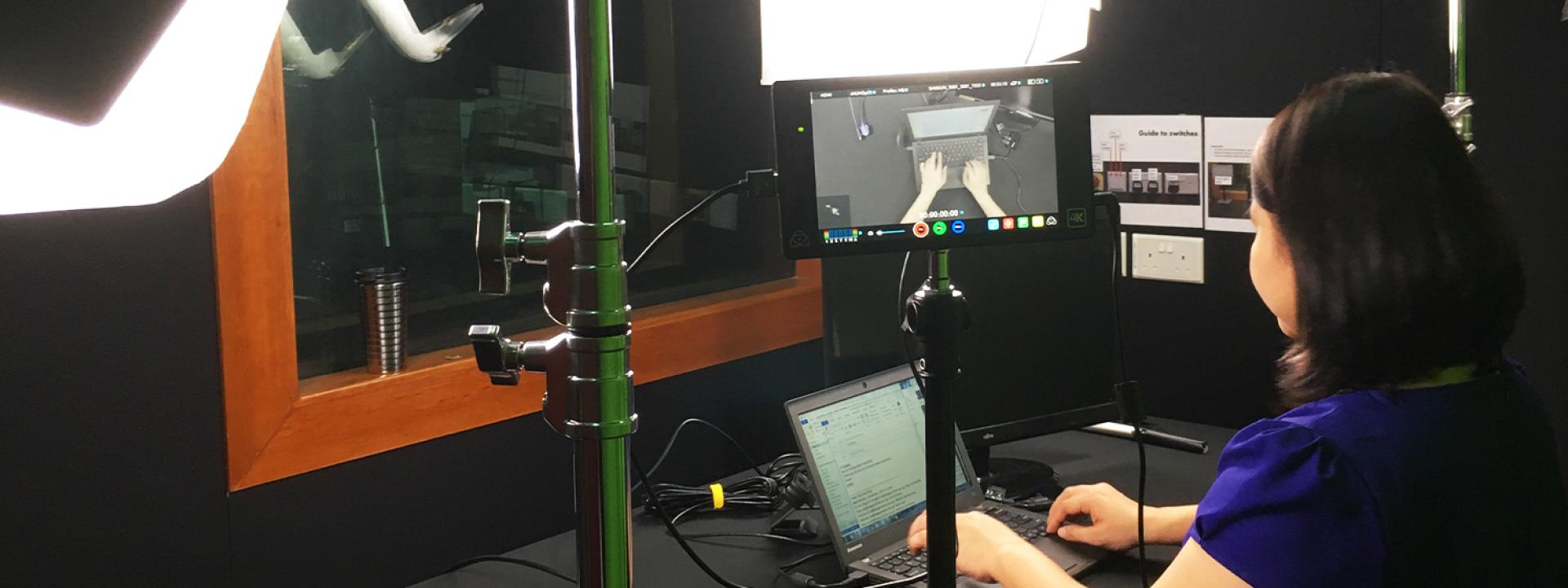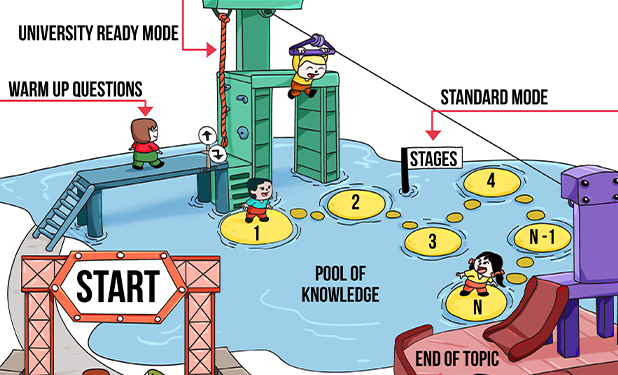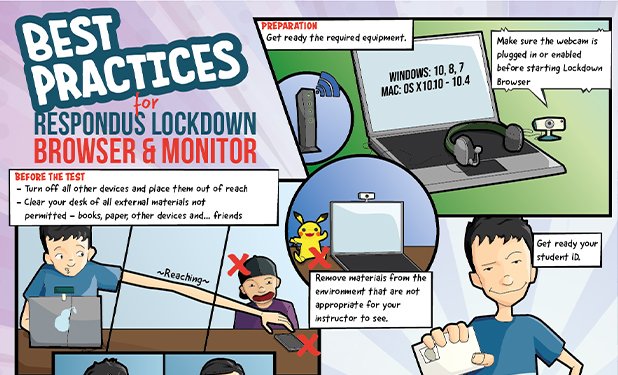
Media Projects
GRAPHICS AND INFOGRAPHICS

Quest Roadmap
This illustration of Math Quest, an e-learning platform, helps students know what to expect and gives them an overview of the entire learning journey at a glance.
Best practices for Respondus Lockdown Browser and Monitor
With SIT’s move to online assessments using the Respondus Lockdown Browser and Monitor, we seek to communicate to students the dos and don’ts in an engaging way. The comic strip draws attention to issues pertinent to the use of the application and directs students to a detailed online guide.

INSTRUCTIONAL AND EXPLAINER VIDEOS
Compared to static images, videos with clear, step-by-step instructions are more effective for demonstrating experiments or procedures. Video lessons also give students control over their learning pace as they can pause, rewind, or slow the playback speed.
By incorporating animations, graphics, diagrams, symbols, metaphors and a variety of characters into videos, we can also deliver messages in a creative and less complicated way.
Project examples
Industrial robotic lab instructional videos
This series of videos illustrates operating procedures for the robotic arm in the robotics laboratory, from starting it up to basic programming. By acquiring the fundamentals beforehand, students can get straight to work during lab sessions.
Computer engineering pre-laboratory video demonstration
Created for flipped classroom lessons, this video made it possible to turn part of an Engineering Programme’s practical lab session into a home-based learning experience. The video highlights the fundamentals and crucial points of the lab sessions.
Biomolecular science II pre-laboratory demonstration
This video is part of a collection that shows the correct way of conducting a laboratory experiment, while highlighting common errors. After watching the video, students are assessed on their knowledge through a quiz before the actual lab experiment.
Video series on financial education
How do you teach non-accounting learners the financial aspects of project evaluation? We created a series of animated videos to educate students on important financial concepts in relation to the financial tools on a website and information on design thinking and lean management. This is to encourage them to rationally evaluate potential innovation projects.
BRINGING THE WORLD TO THE CLASSROOM
It is difficult or dangerous to take more than 100 learners to a worksite, an industrial plant or a restricted area. A video or virtual walkthrough allows learners to immerse themselves in the actual environment without being physically present in the space. In the same way, learners can gain insights into the multiple facets of the workplace through interviews with industry partners and documented footage of key processes and innovations.
Project examples
360 virtual museum tour
The Anatomy Museum in the Yong Loo Lin School of Medicine at National University of Singapore (NUS) is home to a collection of over 400 specimens, arranged according to the human body’s systems. A virtual tour was created for learners to experience the museum and its exhibits.
Singapore: Imagining the next 50 years
Together with other institutes of higher learning, SIT contributed to a series of videos about the need for national defence. The project aims to encourage undergraduates to reflect on Singapore’s post‐independence history, imagine the Singapore they would like to co‐create for the future, and deliberate on what it takes to achieve their vision. The following video was directed by our faculty, Assistant Professor Charles Carroll.
Healthcare innovation video series
This series is a collection of interviews with healthcare innovators such as SmartPeep, an AI health-tech company that has developed an automated monitoring system for various healthcare settings. The videos highlight the innovators’ process, from conceptualisation to prototyping and testing, as well as the challenges faced and the resulting solutions.
CASE STUDIES
The recreation or re-enactment of specific stories or scenarios can be helpful aids to make training relevant and meaningful to learners. Such scenario-based e-learning allows learners to reflect on the information and pick up the necessary skills to respond to similar experiences in real life.
Project examples
Scenario-based videos for applied research
To develop students’ competencies in conducting industry applied research, students must be taught how to conduct proper research. We produced a series of scenario-based videos to guide them in formulating valid applied research questions. The following video showcases the acting talents of SIT's faculty and Professional Officers.
Patient-Nurse communication
Real-life scenarios were re-enacted by SIT’s senior students to provide an authentic way of teaching proper patient handling and communication to their juniors’ training to become future healthcare professionals.
SCRUM methodology
Scrum is an agile software development approach that focuses on short sprints with a release of a sub-product at the end of each sprint. In this video series, the Scrum process is explained and illustrated through documented footage of an actual sprint cycle for the development of a web application.
Workplace safety video for the hospitality business (IWSP)
Safety videos are a dime a dozen. To grab students’ attention, we produced a video to highlight important safety practices in a light-hearted way.
SIMULATIONS AND INTERACTIVE EXPERIENCES
When built as an e-learning package, interactive elements such as non-linear timelines and navigation signposts can give learners autonomy to navigate their decisions at their own pace, while testing their understanding of concepts learned in class. These feature-rich content can also be presented as a virtual simulation with game elements to encourage learner engagement.
Project examples
Wind tunnel interactive package
Through a sequence of explainer videos delivered on an interactive interface with interactive infographics, this simulation gives students a comprehensive understanding of the wind tunnel before their hands-on session in the Wind Tunnel lab.
Visualisation of the vestibular system
To aid in the diagnosis and treatment of patients experiencing vertigo, we created an application for learners to visualise the workings of the internal ear in 3D. This enables them to understand how different head movements and treatment options affect the ear canal.
PRODUCTIONS BY ACADEMIC STAFF
As subject experts, our academic staff are also involved in the creation of their own e-learning content to supplement in-class teaching. With e-learning content, students have the flexibility and convenience to learn remotely at their own pace while having the opportunity for deeper discussions or hands-on practice during classroom interactions.
Project examples
Recorded lecture presentations
Using our Self-recording Studio and Interactive Board System, academic staff can record their lectures and use these videos as e-learning content on our learning management platform. Visit the Edtech Tools and Resources page to find out more about the tools you can use to record such lecture presentations.
Camtasia resources
Camtasia has been a go-to tool for some colleagues to incorporate lecture presentations with formative assessments such as quizzes. Using the software’s screen recording and editing capabilities, coupled with an intuitive interface, they can create high-quality interactive content relatively quickly and easily. Visit the Edtech Tools and Resources page to find out more about Camtasia.